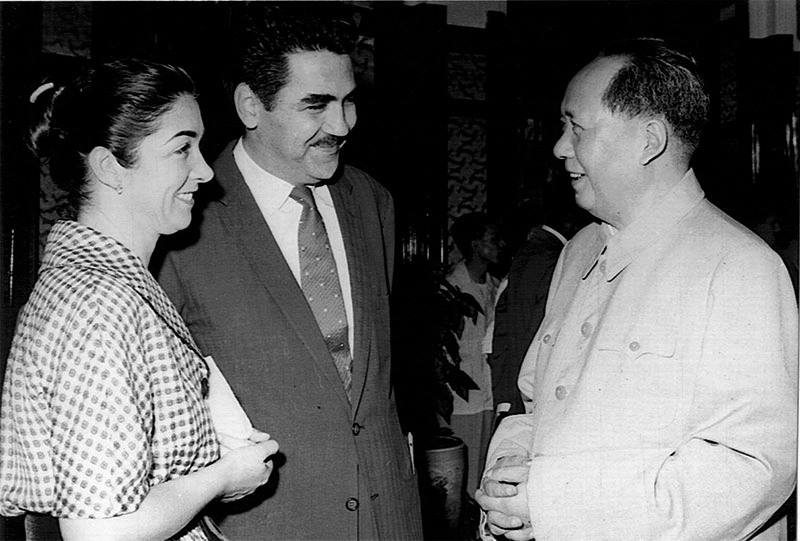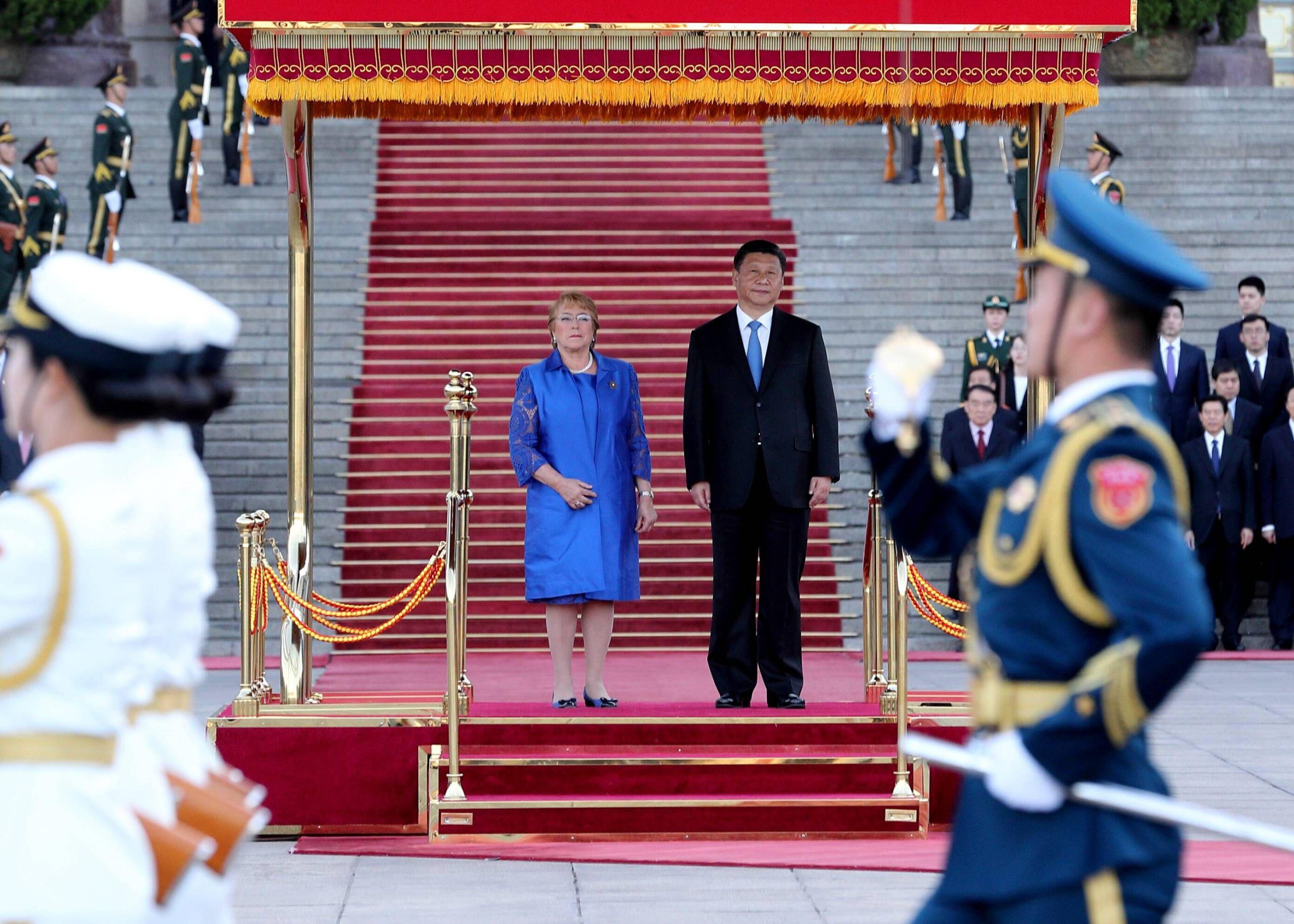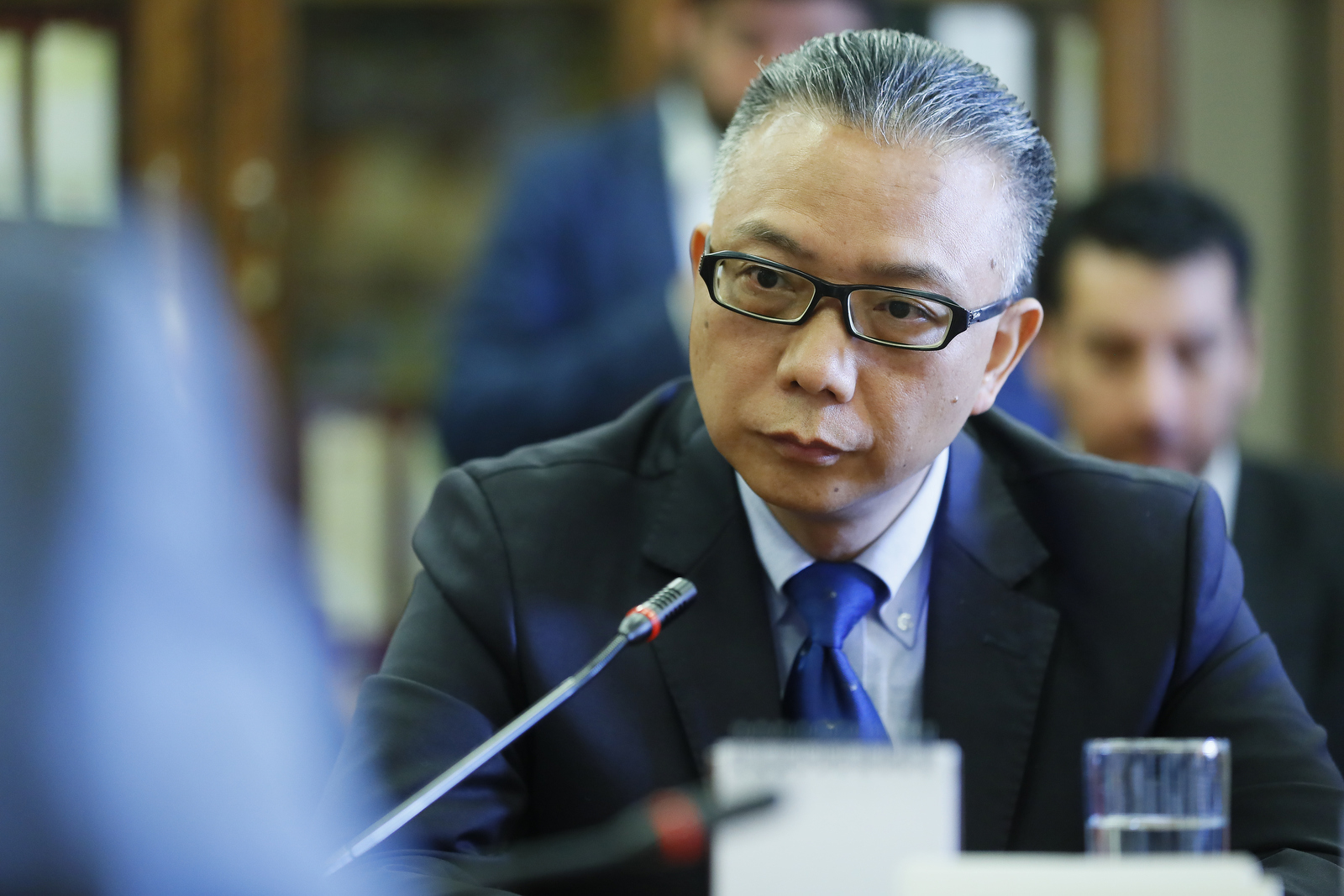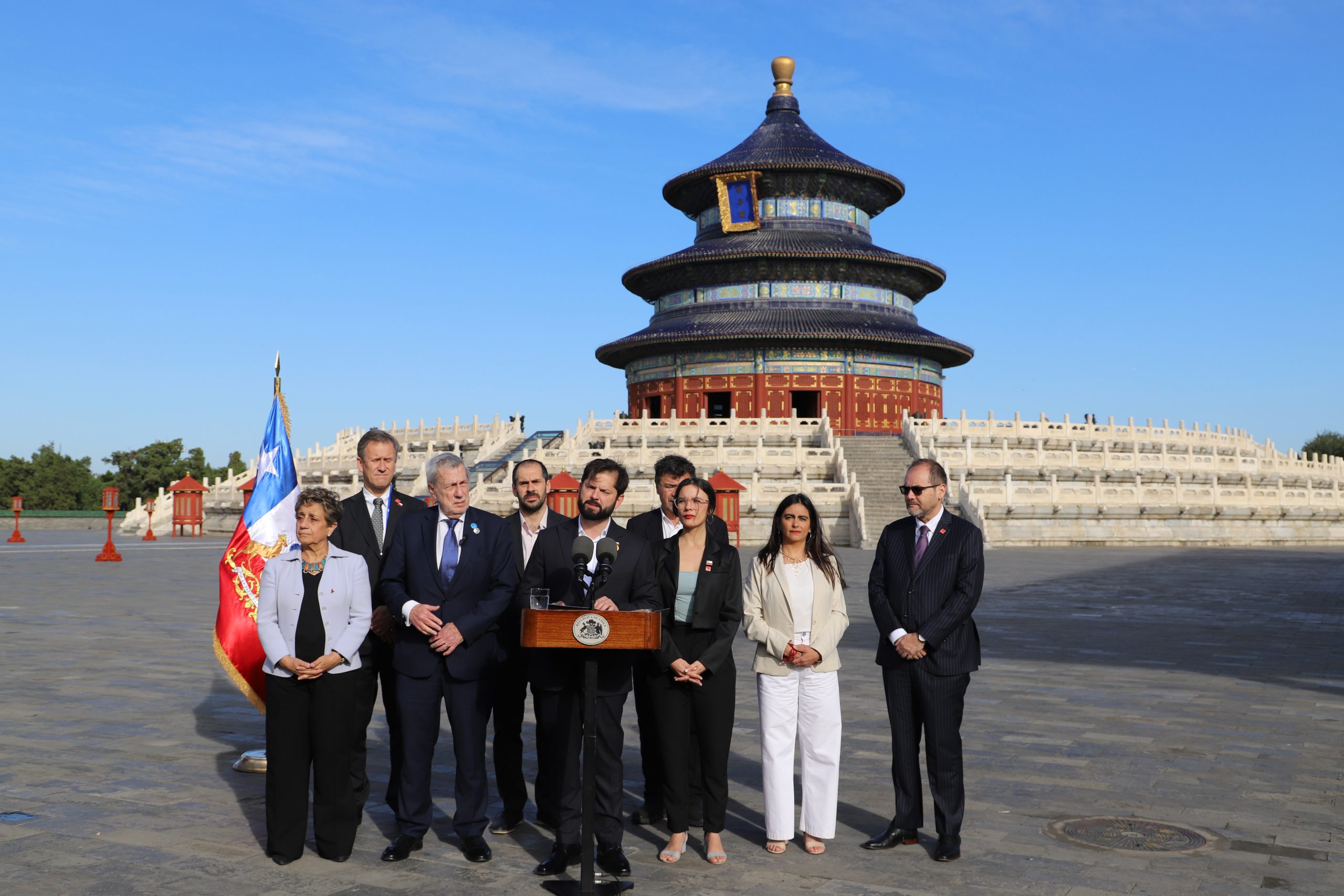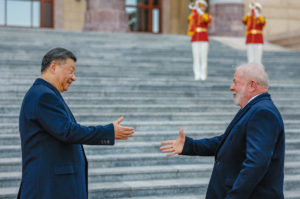It has been more than 50 years since diplomatic relations were established between China and Chile, bringing together two nations separated by nearly 20,000 kilometres of ocean. Chile has been the first South American nation to reach many key milestones in relations with China, and Chinese leader Xi Jinping has spoken warmly of their “special relationship”. Now, the pair are entering a new phase of green cooperation and investment which looks set to draw them closer still.
1970 to 2001: Cultural beginnings
In 1952, the Chilean muralist José Venturelli travelled to China to attend a conference. He fell in love with the country, returning many times and eventually seeing out his days in Beijing, where he died in 1988. A committed socialist and supporter of Mao Zedong, he is said to have worked as an informal diplomat for China in Latin America, and in promoting Maoism in the region during the 1950s and early 1960s. Hoping to consolidate exchanges between the two nations, Venturelli co-founded the Chilean-Chinese Cultural Institute in Santiago in the 1950s, alongside poet Pablo Neruda and the country’s future socialist president, Salvador Allende (1970–1973).
It was under Allende’s leadership that Chile became the first South American country to recognise and establish diplomatic relations with the People’s Republic of China, on 15 December 1970. A year later, at the 26th United Nations General Assembly in New York, Chile demanded the “restitution of the legitimate rights of the PRC,” backing China’s successful readmission to the UN.
“The first phase of the Chile-China relationship was marked by cultural ties, but there were also diplomatic favours exchanged,” explained Andrés Bórquez, coordinator of the Asian studies programme at the University of Chile’s international studies institute.
“The Pinochet dictatorship put paid too much of that with its strong anti-communist discourse, yet paradoxically neither Chile nor Beijing cut ties, realising the importance of the relationship.”
When Chile suffered its bloody democratic breakdown, following General Augusto Pinochet’s 1973 coup d’état that overthrew Allende’s government, relations survived despite opposing ideologies with China’s then-leader Deng Xiaoping. Commercial ties with Chile began to form as Deng sought to modernise China’s economy, with materials such as copper in growing demand.
Diplomatically, Chile stood firm behind the One China policy and received support for its Antarctic claim in return, reciprocated in 1984 when China was permitted to build its Great Wall research station on a sliver of the Antarctic Peninsula claimed by Chile.
The 2000s: Commodities and free trade
In December 2001, Chile vocally backed China’s accession to the World Trade Organisation, becoming the first Latin American country to do so, and pointedly recognised the PRC as a “market economy” during the 2004 visit of Chinese Communist Party general secretary Hu Jintao to the Asia-Pacific Economic Cooperation (APEC) summit in Santiago.
This approach paid off. In 2005, Chile became the first individual nation to sign a free trade agreement with the PRC. Only the Association of Southeast Asian Nations (ASEAN) had done so previously, with its countries signing a deal as a bloc in 2002. The FTA entered into force in 2006, seeing Chile take full advantage of booming demand for commodities in Asia, notably its copper, and building on an FTA with South Korea signed in 2003, and healthy trade with Japan.
US$57.2 billion
The total value of trade between China and Chile in 2023, according to Chile’s foreign ministry. Of this, $37.4 billion was exports from Chile, making it one of the few countries in Latin America to have a trade surplus with China.
In 2005, China was Chile’s third-largest export market, sending goods across the Pacific Ocean totalling more than US$4.8 billion. Total trade between the two countries that year was US$8 billion. By 2010, that had risen to over US$27.2 billion. In 2023, it reached $57.2 billion, according to Chilean foreign ministry data.
In 2009, with trade the undisputed backbone of the binational relationship, China became Chile’s main economic partner.
“China’s market is critical for Chile, which fosters a certain dependency dynamic which is evident across the region, but is particularly pronounced in Chile,” said Margaret Myers, the director of the Asia & Latin America Program at the Inter-American Dialogue.
Chile’s dependency on China has manifested through its trade relations and beyond. In 2022, China was the destination for 39.4% of Chile’s exports, including around 70% of all its copper exports. Chile’s agricultural and seafood exports to China have also steadily increased in recent years. Most recently, deepening ties in the energy and technology sectors have seen concerns raised over Chile’s wider independence from its main trading partner, with even President Gabriel Boric expressing caution over the possible risks of such dependency.
For Guo Cunhai, coordinator of the Beijing-based Centre for China and Latin America Studies, “pragmatism is the cornerstone” of China-Chile relations. “President Xi Jinping said that the China-Chile relationship is a forerunner of China-Latin America relations and a model of South-South cooperation.”
The 2010s: More trade, investments and Covid
A diplomatic charm offensive has often accompanied pragmatic trade relations. Every single Chilean president since 1990 has visited China at least once. Between 2015 and 2019, Chinese foreign minister Wang Yi visited Chile four times. Chile is the only country in Latin America whose presidents have participated in all three summits of China’s Belt and Road Initiative, having signed up to join in 2018.
“Trade has been the driving force of this relationship,” said Jorge Heine, who served as Chile’s ambassador in Beijing between 2014 and 2017. “No country [in Latin America] sends a larger share of its exports to China, but what had been lagging was Chinese investment in Chile.”
When Heine was dispatched to Beijing in 2014, Chilean president Michelle Bachelet assigned him the task of increasing foreign direct investment as a priority. Whereas Chinese companies poured tens of billions of dollars into Brazil, Peru, Ecuador and Argentina, Chile had little to show for its efforts.
“At the beginning of the 2010s, Chile was in the top 15 FDI destinations anywhere in the world, but there was a question as to why it wasn’t attracting Chinese investment,” said Ignacio Tornero, who works with Chinese and Chilean companies through his consultancy, East Consulting.
“One of the reasons was that there wasn’t a lot of experience in China investing abroad – they were used to dealing government-to-government, but started to work out that sending younger envoys to work out the local regulatory landscape was key to doing business in Chile.”
Most experts point to Chilean trade body ProChile’s tireless work in China promoting investment and setting up links between businesses on each side of the Pacific Ocean.
Big deals soon started to roll in. According to a report published by the Inter-American Dialogue in January, Chile did not figure among the top 10 destinations for Chinese investment until 10 years ago, when it crept in at the bottom of the list.
Since 2018, it has been the top destination in Latin America and the Caribbean for Chinese FDI, with over 90% of these investments currently in the mining and power sectors.
In 2016, the Chinese State Power Investment Corporation bought the formerly Australian-owned power company Pacific Hydro, with its US$1 billion in assets in Chile, and in 2018, Tianqi Lithium bought out 24% of SQM, Chile’s main lithium producer, from a Canadian shareholder for US$4 billion.
This latter deal rocked the boat. Chilean authorities delayed the deal, fearing behind-closed-doors discussions could lead to potential tax revenue losses. Chinese ambassador Xu Bu fired a warning shot and commented that this could affect Chile’s relationship with China; he was even recalled to Beijing in response. It was eventually agreed that Tianqi employees would not sit on SQM’s board, nor would they have access to sensitive information.
Since Chile’s return to democracy in 1990, “there has been a foundational principle of non-discrimination along lines of nationalities of companies in Chile, coupled with a reluctance to make politically-motivated decisions,” said Zara Albright, a doctoral candidate studying Chile-China relations at Boston University.
However, in 2020, members of Chile’s parliament from across the political spectrum warned ominously that China was “buying Chile.” A bill submitted to congress by an economic affairs committee would have required two thirds of parliament to approve any investment project by foreign state-owned enterprises, but it never moved through the legislature.
Bórquez says that there is still no political consensus on increased Chinese investment in Chile, with some sectors calling for screening or potential investment to avoid domination of key sectors, while others prefer adherence to Chile’s history of non-discrimination.
Chile has a very strong relationship with the United States and China. Until now, it has managed to balance that very wellJorge Heine, former Chilean ambassador to China
Other fears emanated from the north, too. Amid a US campaign to freeze telecoms giant Huawei out of global tech projects, a plan to connect the Chilean city of Valparaiso and Shanghai by submarine fibre optic cable was shelved after the then US secretary of state Mike Pompeo visited Chile in April 2019 to express his concerns. Former president Sebastián Piñera had even visited Shenzhen, China’s tech hub, in 2019 to seek similar deals.
“Traditionally, Chile has had a very strong relationship with the United States and China,” explained Heine. “Until now, Chile has managed to balance that very well, and I see no reason why it shouldn’t be able to continue doing so in the future.”
The 2010s came to a close with the Covid-19 pandemic, during which Chile depended heavily on China for supplies of masks, respirators and personal protective equipment. It secured early access to vaccines produced by the Chinese laboratory Sinovac Biotech, long before they became available elsewhere, helping the nation in eventually achieving the fifth-highest vaccination rate in the world.
2020 to now, and beyond: Green partners?
After reaching 50 years of diplomatic relations in 2020, Chile and China are now entering a new phase in their relationship. The expansion of renewable energy infrastructure, green hydrogen and lithium mining offer new areas of collaboration, trade and investment.
A roadmap for the relationship was set out when President Gabriel Boric visited China in October last year. His foreign minister Alberto van Klaveren signed 13 agreements to add to the bilateral relationship, modernising ties with an MOU that included talk of sustainable development and green energy pledges.
“Chile has huge advantages in developing solar, wind and hydrogen energy, while China is a global leader in clean energy technology: both sides have great potential for cooperation in green development,” said Guo Cunhai.
Chile has abundant renewable energy resources at a very competitive price, making it an ideal location for green hydrogen production, technology that China is actively developing. Chile’s installed solar capacity has more than tripled since 2018, reaching over 9 gigawatts by the end of 2023, while wind power capacity reached 4.8 gigawatts.
“There are expectations that the EU might be a big player in the future with Chile on green hydrogen, but China is very interested in developments in that space, too,” said Rebecca Ray, a senior academic researcher with the Global China Initiative at the Boston University Global Development Policy Center.
“It may be that Chile’s stance around pragmatism and non-discrimination could work in its favour, but there is certainly a natural complementarity between China and Chile’s ambitions in the green transformation space.”
Chile has ambitious plans in sustainable infrastructure, including the expansion of ports, airports and trains, while China has vast experience in construction and financing such projects.
Chinese power companies’ ultra-high voltage transmission technology – power lines which retain voltage over long distances – could be crucial if Chile is to transport energy generated in the northern Atacama Desert, with its world-leading solar power potential, to population centres further south. In 2020, an agreement was signed between the world’s largest power company, China’s State Grid-SGID and Empresa CGE, Chile’s main power distributor for US$3 billion. As of 2023, 57% of Chile’s national grid was Chinese-owned.
Other green technologies and minerals are vital to the relationship moving forward. With Chile the home to around 44% of the world’s known lithium deposits – crucial for the battery technology for which Chinese companies dominate supply chains – businesses have cast their eyes towards the salt flats in the north of the country.
In January 2022, Chinese vehicle and battery maker BYD won one of five lithium exploitation tenders in Chile, and says it wants to make electric batteries in the country – a crucial step as the South American country looks to add value to its exports. Tianqi, meanwhile, is now lobbying to increase its SQM stake.
China has also become a notable contributor to efforts to green Chile’s transport sector. Santiago has the largest fleet of electric buses of any city outside China, with the lithium battery-charged vehicles provided by Chinese companies BYD, King Long and Yutong. Electromobility continues to be a focus for Chilean green energy efforts and Chinese exports alike.
Chinese diplomats and business leaders, Myers said, “have worked hard to promote Chinese investment into certain sectors in Chile, and that includes Chile’s energy transition. China must invest in these sectors in order to be competitive in the future.
“Chile is a recipient of trade and investment in these high-tech and innovation-related sectors, on the one hand, and on the other is a key part of the supply chain that will feed them – that’s another reason why we’ve seen this boom in interest in Chile.”
Chile has signed more cooperation agreements with China than any other South American country. To lessen dependency fears, it is also trying to diversify its export partners with a new FTA with Indonesia and the EU, and has a preferential trade agreement with India, in force since 2007.
“My feeling is that the relationship is going to deepen with respect to Chinese investment in sectors like electromobility and infrastructure, above all through public tenders,” said Bórquez.
New collaborative infrastructure projects in this vein are forthcoming. Recent tenders won by Chinese contractors include two sections of the Ruta 5 highway, a new seventh metro line for Santiago, and a hospital in the northern city of Coquimbo.
“For Chile, the main challenge is how it can add more value to the copper and lithium it is sending to China,” said Heine. “If that happens, it would be a real game changer.”

